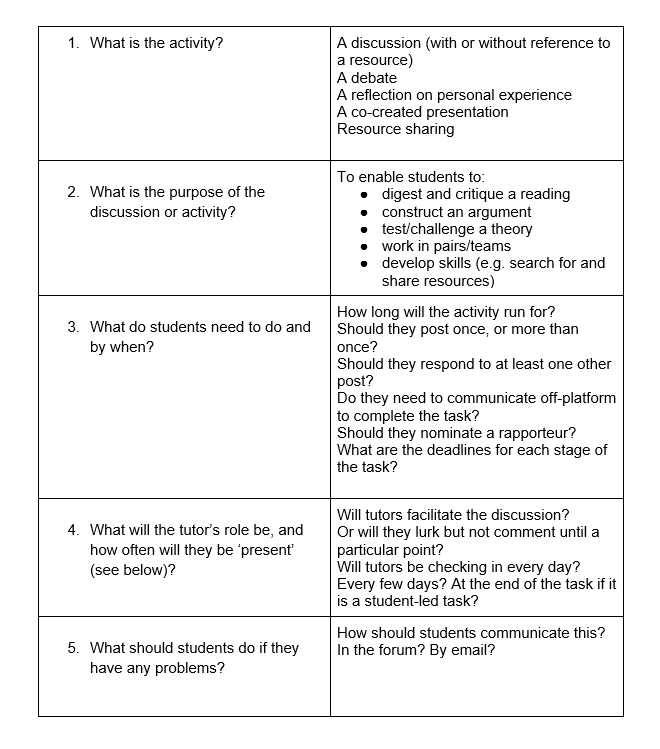Designing Learning and Teaching Online: The Role of Discussion Forums
Following the cessation of campus-based teaching around the world, advice has been pouring in about how to migrate courses online. Much of this advice has been about technology, which of course is key to getting started in a new online teaching environment. But the shift to online study should also address how we design learning activities and teaching practices. As colleagues begin to work online, it will become obvious that both of these things are different when working online, and both need significant attention. This brings both opportunities and challenges. 
One particular opportunity afforded by learning online is the use of asynchronous discussion forums. This type of forum can be used to create meaningful group discussions, equivalent to seminars in campus-based teaching. These discussion activities are ‘asynchronous’ as they take place over a set period of time (typically a week or two), with students benefiting from being able to choose when they engage and what their engagement will focus on. The discussion develops as it builds over time, arguably creating richer discussion and enabling greater flexibility than the traditional seminar, but they can be more difficult to steer and navigate.
At York, we have been delivering wholly online, distance-based programmes for some time, and we thought it might be useful to share our experience of teaching using asynchronous discussions. Tips 1 and 2 concern the design of learning activities, while tips 2 – 7 concern teaching practice.
1. Set clear expectations
Our experience points up the importance of making clear to students what they are being asked to do and by when. This is likely to be especially important in the current situation, as students are being asked to make a transition to a new way of working. Those who have been studying online from the outset will have deliberately signed up for this mode of study, and so will be attuned to it, but for students who are only now moving to online study, in the middle of their studies, perceptions may be very different. Clarity about what to expect is therefore very important. To enable us to design clear and purposeful group activities, we have developed the ‘Five Questions’ framework:

Answering these questions not only helps with setting clear expectations for students, but also helps tutors to be clear about what they are doing and why.
Tip for tutors: use these questions as a checklist when setting up an online student activity.
2. Keep activities to one main function or question
Activities seem to work best when the focus is clear and the task is relatively contained, so aim to design activities that address only one theme or one question, with perhaps a second, related question to supplement the discussion as it develops. This helps to discourage multiple ‘threads’, (vaguely related tangents), which can become difficult to facilitate and are frustrating for students to follow.
Tip for tutors: start the discussion off by repeating the key question that you want them to consider and remind them of it as the discussion progresses.
3. Make space for students to share views about studying online
 This tip is also likely to be particularly relevant in the current situation. Providing some space for students to share their views about this mode of study helps students to feel ‘heard’. Moreover, students typically respond positively by offering their own tips and advice.
This tip is also likely to be particularly relevant in the current situation. Providing some space for students to share their views about this mode of study helps students to feel ‘heard’. Moreover, students typically respond positively by offering their own tips and advice.
Tip for tutors: invite students to generate their own list of ‘rules for engagement’ at the start of the first online forum, as a group. This creates a sense of ownership and a constructive sense of community, and adds to clarity.
4. Practice regular, though less intense, engagement
On campus-based courses, there are usually peaks of teaching activity around the class itself, followed by a drop. In online courses, engagement is less ‘punctuated’ and more continuous throughout the week This requires a more regular tutor ‘presence’, with interactions taking place over the whole week rather than just once a week.
Thus, greater responsiveness is needed, but it is also important to avoid ‘hyper-responsiveness’. Chasing to respond to every student’s point as it is posted in the forum can be disruptive, as it limits the time for the other students to process and reflect on the discussion, and it can prematurely ‘move’ the debate forward. It can be helpful to allow for a debate to evolve around one or two similar points, so that the tutor’s response can be structured around coherent sets of issues.
Tip for tutors: Try to strike a balance between being responsive and being hyper-responsive. While there is no rule of thumb, we suggest it is good practice to post every 24h-48h.
5. Prompt early discussion
One shared impression amongst our teaching staff is that an early start to a topic is likely to set in motion a higher level of engagement from the students, leading to more insightful discussions as the week/fortnight progresses.
Tip for tutors: Try to prompt at least one or two student responses on Day 1 of every activity. Students can be encouraged not to wait to complete the reading (if there is any for the task) but instead to begin to respond based on an initial skimming of the abstract or of other ‘signposts’.
Some good early prompts include asking them to share initial thoughts, or guesses, on what the topic is about, what the key questions might be, whether they are looking forward to this activity and why. Such early reflections will enable students to ‘start small’ and more easily transition towards deeper engagement, without being ‘stuck’ for several days.
6. Keep it short and structured (bullet-points welcome)
In an offline setting, talking in multiple sentences and addressing tangents is the norm but in an online setting wordiness can be detrimental to the task; with longer posts, there is also more danger of participants veering off the topic. As the discussion builds, it can become more difficult for the rest of the group to keep track of the main thread in the discussion.
Tip for tutors: Encourage students to produce concise posts and, wherever possible, to use ‘visuals’ such as bullet-points. Breaking down paragraphs into two to three sentences can greatly ease the reading experience and foster better student engagement. This, of course, does not mean simplification: the ‘deep’ should always be prioritised over the ‘banal’, but conciseness helps. You can also propose a word limit to discourage verbosity – 200 is plenty!
7. Mitigate for non-verbal communication 
When participants are not physically present in a room, the normal paralinguistic cues and clues are absent and so it is easier to misunderstand the meaning, tone and mood of a written message. Such misunderstanding can prompt negative responses and potentially spiral into tension. This risk may increase when the group is culturally diverse, as acceptable tones and levels of assertiveness vary across cultures, or when the participants do not yet know each other well.
It is therefore crucial for both tutors and students to remain aware throughout the course that unintended miscommunication can easily arise. This can be mitigated by agreeing to the principles of ‘netiquette’ and establishing some ground rules.
Tip for tutors. It is worth outlining right at the start of a course the importance of tolerance, both when receiving and giving critical remarks. If miscommunication does arise, the tutor can reach out to the participants 1 to 1 (via email or dedicated chat spaces for tutor-student interactions), rather than drawing attention to the issue in the discussion space. However, on the rare occasion a student gives offence, this should be addressed quickly in the discussion itself.
****
In summary, our experience suggests that while technology is a crucial enabler for online learning, when it comes to small group teaching the most important success factors concern the design of the learning tasks, and the practice of teaching.
Ellen Roberts leads our ‘Rethinking Governance – Online’ programme which allows participants to improve their understanding of the context of HE and explore some of the key issues demanding the attention of senior leaders and Governors. Find out more and book your place here.
Dr Slobodan Tomic is a Lecturer in Public Management and Director of the online Masters in Public Administration (MPA) at the University of York (Department of Social Policy & Work). After teaching on a range of campus-based courses, at the London School of Economics (LSE), University College London (UCL) and University College Dublin (UCD), during his doctoral and post-doctoral career, he joined last year the University of York to teach on online modules on the Masters in Public Administration (MPA).
Prof. Ellen Roberts is Director of Online Studies at the Department of Social Policy & Work at the University of York, where she has overseen online distance learning programmes for public service professionals since 2003. She is a National Teaching Fellow, and Senior Fellow of the Higher Education Academy.
Jane Lund is a Senior Educational Designer for the online Masters programmes in the Department of Social Policy and Social Work at the University of York. She has been responsible for the design and implementation of good practice in the development of online teaching and learning for 17 years at York.
Advance HE Connect is our dedicated online network for the HE sector. Join the Learning and Teaching Network for online teaching support, resources and discussion.
Originally published here.
